Economics Article Review: Customer Satisfaction and Loyalty Analysis
VerifiedAdded on 2023/06/04
|6
|1401
|201
Essay
AI Summary
This essay provides a critical review of an economics article focusing on customer satisfaction and loyalty. It summarizes the main points of the article, analyzes the accuracy of its use of economic concepts, and discusses its relevance to microeconomics. The essay identifies and explains the microeconomic models and theories implicit in the article, such as demand and supply, market structures (perfect competition, monopoly, monopolistic competition, and oligopoly), and utility theory. It further examines how customer satisfaction influences demand and how firms differentiate their products to foster customer loyalty, especially during economic downturns. The review also evaluates the article's writing style and its contribution to understanding microeconomics, highlighting the interrelation of microeconomic models in human and firm behavior. Desklib offers this essay along with a variety of study resources for students.
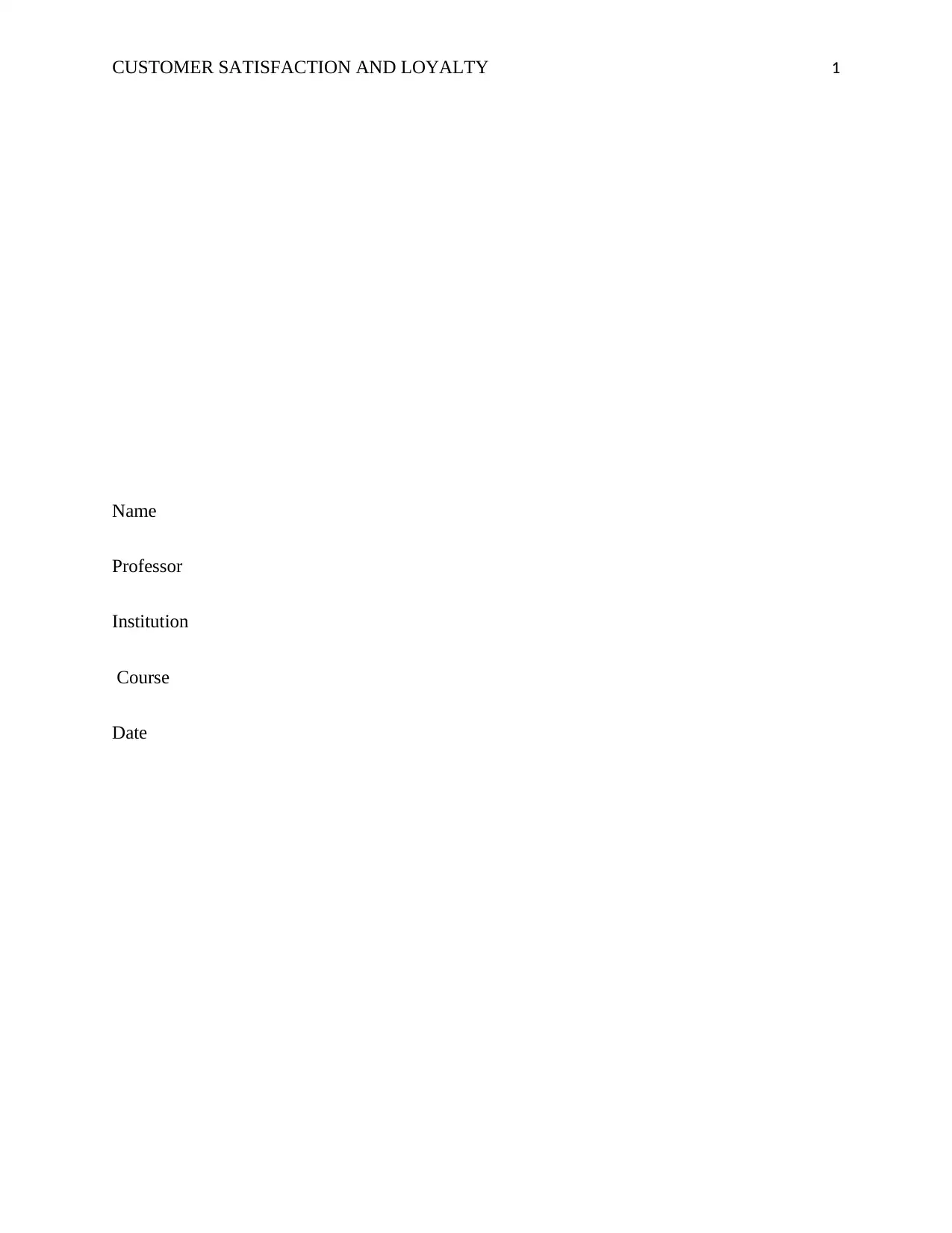
CUSTOMER SATISFACTION AND LOYALTY 1
Name
Professor
Institution
Course
Date
Name
Professor
Institution
Course
Date
Paraphrase This Document
Need a fresh take? Get an instant paraphrase of this document with our AI Paraphraser
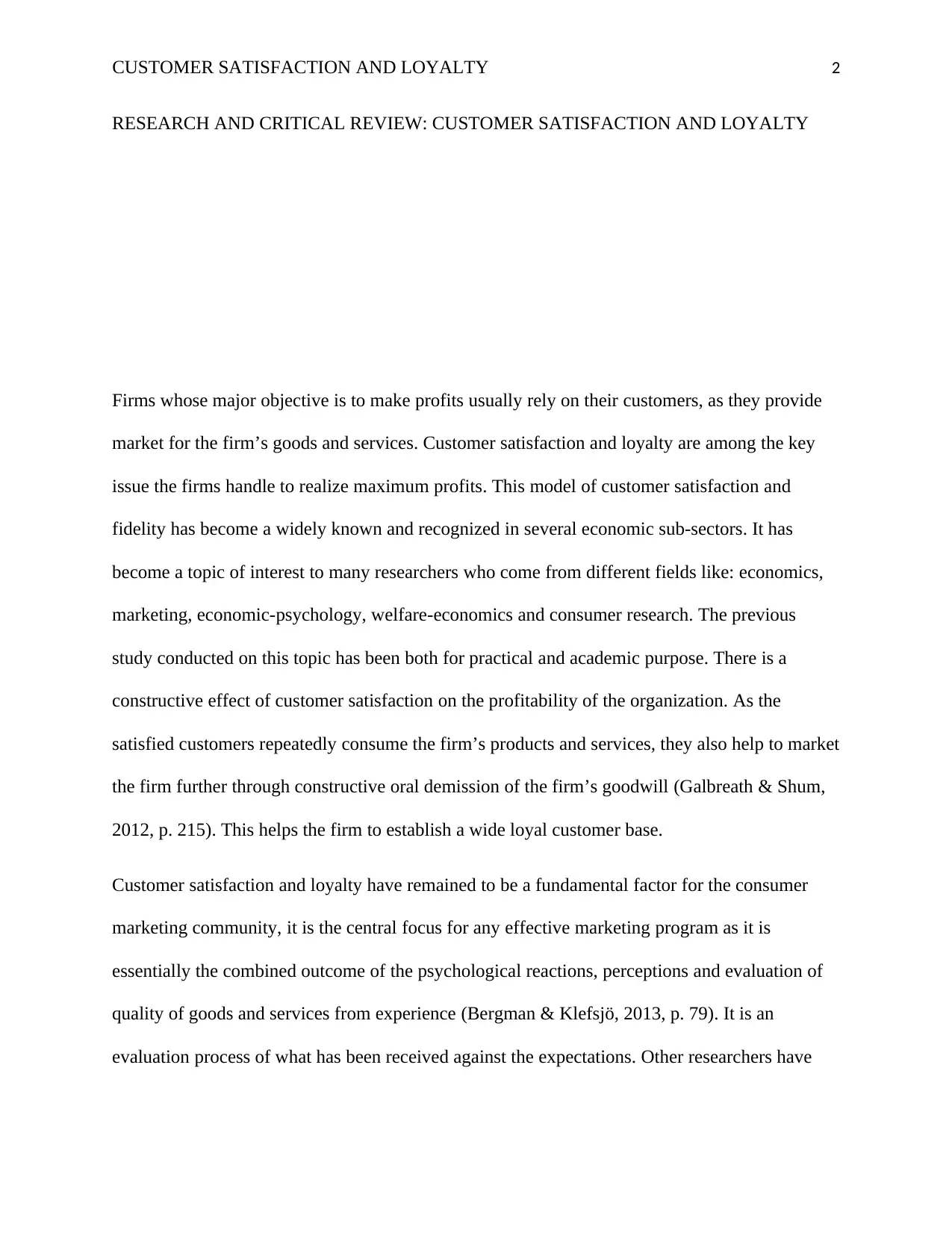
CUSTOMER SATISFACTION AND LOYALTY 2
RESEARCH AND CRITICAL REVIEW: CUSTOMER SATISFACTION AND LOYALTY
Firms whose major objective is to make profits usually rely on their customers, as they provide
market for the firm’s goods and services. Customer satisfaction and loyalty are among the key
issue the firms handle to realize maximum profits. This model of customer satisfaction and
fidelity has become a widely known and recognized in several economic sub-sectors. It has
become a topic of interest to many researchers who come from different fields like: economics,
marketing, economic-psychology, welfare-economics and consumer research. The previous
study conducted on this topic has been both for practical and academic purpose. There is a
constructive effect of customer satisfaction on the profitability of the organization. As the
satisfied customers repeatedly consume the firm’s products and services, they also help to market
the firm further through constructive oral demission of the firm’s goodwill (Galbreath & Shum,
2012, p. 215). This helps the firm to establish a wide loyal customer base.
Customer satisfaction and loyalty have remained to be a fundamental factor for the consumer
marketing community, it is the central focus for any effective marketing program as it is
essentially the combined outcome of the psychological reactions, perceptions and evaluation of
quality of goods and services from experience (Bergman & Klefsjö, 2013, p. 79). It is an
evaluation process of what has been received against the expectations. Other researchers have
RESEARCH AND CRITICAL REVIEW: CUSTOMER SATISFACTION AND LOYALTY
Firms whose major objective is to make profits usually rely on their customers, as they provide
market for the firm’s goods and services. Customer satisfaction and loyalty are among the key
issue the firms handle to realize maximum profits. This model of customer satisfaction and
fidelity has become a widely known and recognized in several economic sub-sectors. It has
become a topic of interest to many researchers who come from different fields like: economics,
marketing, economic-psychology, welfare-economics and consumer research. The previous
study conducted on this topic has been both for practical and academic purpose. There is a
constructive effect of customer satisfaction on the profitability of the organization. As the
satisfied customers repeatedly consume the firm’s products and services, they also help to market
the firm further through constructive oral demission of the firm’s goodwill (Galbreath & Shum,
2012, p. 215). This helps the firm to establish a wide loyal customer base.
Customer satisfaction and loyalty have remained to be a fundamental factor for the consumer
marketing community, it is the central focus for any effective marketing program as it is
essentially the combined outcome of the psychological reactions, perceptions and evaluation of
quality of goods and services from experience (Bergman & Klefsjö, 2013, p. 79). It is an
evaluation process of what has been received against the expectations. Other researchers have
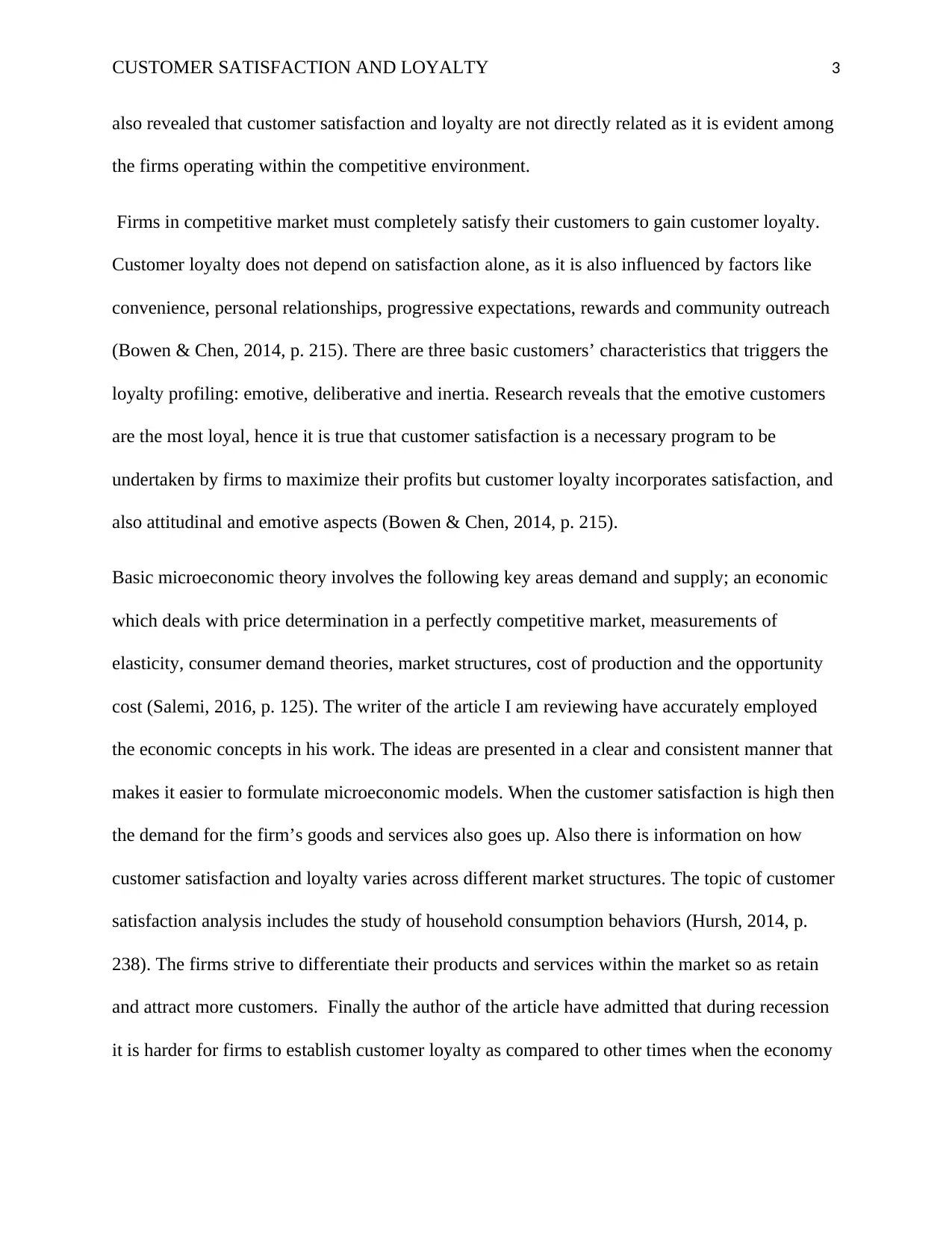
CUSTOMER SATISFACTION AND LOYALTY 3
also revealed that customer satisfaction and loyalty are not directly related as it is evident among
the firms operating within the competitive environment.
Firms in competitive market must completely satisfy their customers to gain customer loyalty.
Customer loyalty does not depend on satisfaction alone, as it is also influenced by factors like
convenience, personal relationships, progressive expectations, rewards and community outreach
(Bowen & Chen, 2014, p. 215). There are three basic customers’ characteristics that triggers the
loyalty profiling: emotive, deliberative and inertia. Research reveals that the emotive customers
are the most loyal, hence it is true that customer satisfaction is a necessary program to be
undertaken by firms to maximize their profits but customer loyalty incorporates satisfaction, and
also attitudinal and emotive aspects (Bowen & Chen, 2014, p. 215).
Basic microeconomic theory involves the following key areas demand and supply; an economic
which deals with price determination in a perfectly competitive market, measurements of
elasticity, consumer demand theories, market structures, cost of production and the opportunity
cost (Salemi, 2016, p. 125). The writer of the article I am reviewing have accurately employed
the economic concepts in his work. The ideas are presented in a clear and consistent manner that
makes it easier to formulate microeconomic models. When the customer satisfaction is high then
the demand for the firm’s goods and services also goes up. Also there is information on how
customer satisfaction and loyalty varies across different market structures. The topic of customer
satisfaction analysis includes the study of household consumption behaviors (Hursh, 2014, p.
238). The firms strive to differentiate their products and services within the market so as retain
and attract more customers. Finally the author of the article have admitted that during recession
it is harder for firms to establish customer loyalty as compared to other times when the economy
also revealed that customer satisfaction and loyalty are not directly related as it is evident among
the firms operating within the competitive environment.
Firms in competitive market must completely satisfy their customers to gain customer loyalty.
Customer loyalty does not depend on satisfaction alone, as it is also influenced by factors like
convenience, personal relationships, progressive expectations, rewards and community outreach
(Bowen & Chen, 2014, p. 215). There are three basic customers’ characteristics that triggers the
loyalty profiling: emotive, deliberative and inertia. Research reveals that the emotive customers
are the most loyal, hence it is true that customer satisfaction is a necessary program to be
undertaken by firms to maximize their profits but customer loyalty incorporates satisfaction, and
also attitudinal and emotive aspects (Bowen & Chen, 2014, p. 215).
Basic microeconomic theory involves the following key areas demand and supply; an economic
which deals with price determination in a perfectly competitive market, measurements of
elasticity, consumer demand theories, market structures, cost of production and the opportunity
cost (Salemi, 2016, p. 125). The writer of the article I am reviewing have accurately employed
the economic concepts in his work. The ideas are presented in a clear and consistent manner that
makes it easier to formulate microeconomic models. When the customer satisfaction is high then
the demand for the firm’s goods and services also goes up. Also there is information on how
customer satisfaction and loyalty varies across different market structures. The topic of customer
satisfaction analysis includes the study of household consumption behaviors (Hursh, 2014, p.
238). The firms strive to differentiate their products and services within the market so as retain
and attract more customers. Finally the author of the article have admitted that during recession
it is harder for firms to establish customer loyalty as compared to other times when the economy
⊘ This is a preview!⊘
Do you want full access?
Subscribe today to unlock all pages.

Trusted by 1+ million students worldwide
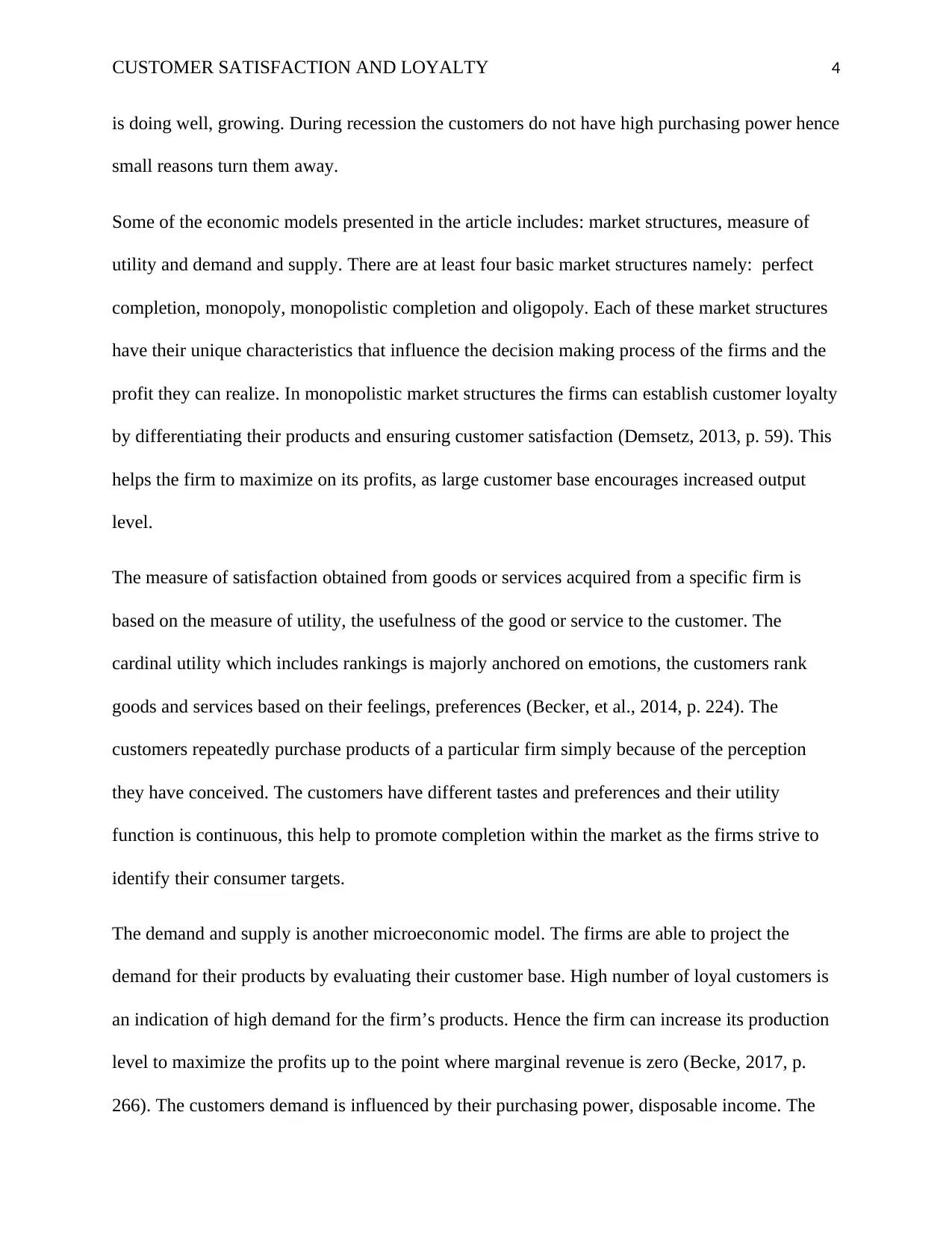
CUSTOMER SATISFACTION AND LOYALTY 4
is doing well, growing. During recession the customers do not have high purchasing power hence
small reasons turn them away.
Some of the economic models presented in the article includes: market structures, measure of
utility and demand and supply. There are at least four basic market structures namely: perfect
completion, monopoly, monopolistic completion and oligopoly. Each of these market structures
have their unique characteristics that influence the decision making process of the firms and the
profit they can realize. In monopolistic market structures the firms can establish customer loyalty
by differentiating their products and ensuring customer satisfaction (Demsetz, 2013, p. 59). This
helps the firm to maximize on its profits, as large customer base encourages increased output
level.
The measure of satisfaction obtained from goods or services acquired from a specific firm is
based on the measure of utility, the usefulness of the good or service to the customer. The
cardinal utility which includes rankings is majorly anchored on emotions, the customers rank
goods and services based on their feelings, preferences (Becker, et al., 2014, p. 224). The
customers repeatedly purchase products of a particular firm simply because of the perception
they have conceived. The customers have different tastes and preferences and their utility
function is continuous, this help to promote completion within the market as the firms strive to
identify their consumer targets.
The demand and supply is another microeconomic model. The firms are able to project the
demand for their products by evaluating their customer base. High number of loyal customers is
an indication of high demand for the firm’s products. Hence the firm can increase its production
level to maximize the profits up to the point where marginal revenue is zero (Becke, 2017, p.
266). The customers demand is influenced by their purchasing power, disposable income. The
is doing well, growing. During recession the customers do not have high purchasing power hence
small reasons turn them away.
Some of the economic models presented in the article includes: market structures, measure of
utility and demand and supply. There are at least four basic market structures namely: perfect
completion, monopoly, monopolistic completion and oligopoly. Each of these market structures
have their unique characteristics that influence the decision making process of the firms and the
profit they can realize. In monopolistic market structures the firms can establish customer loyalty
by differentiating their products and ensuring customer satisfaction (Demsetz, 2013, p. 59). This
helps the firm to maximize on its profits, as large customer base encourages increased output
level.
The measure of satisfaction obtained from goods or services acquired from a specific firm is
based on the measure of utility, the usefulness of the good or service to the customer. The
cardinal utility which includes rankings is majorly anchored on emotions, the customers rank
goods and services based on their feelings, preferences (Becker, et al., 2014, p. 224). The
customers repeatedly purchase products of a particular firm simply because of the perception
they have conceived. The customers have different tastes and preferences and their utility
function is continuous, this help to promote completion within the market as the firms strive to
identify their consumer targets.
The demand and supply is another microeconomic model. The firms are able to project the
demand for their products by evaluating their customer base. High number of loyal customers is
an indication of high demand for the firm’s products. Hence the firm can increase its production
level to maximize the profits up to the point where marginal revenue is zero (Becke, 2017, p.
266). The customers demand is influenced by their purchasing power, disposable income. The
Paraphrase This Document
Need a fresh take? Get an instant paraphrase of this document with our AI Paraphraser

CUSTOMER SATISFACTION AND LOYALTY 5
author of the article have provided extensive literature review and references while presenting
his ideas in a chronological and flowing manner. The economic concepts are also well
incorporated
Microeconomics entails examination of a single cogent and utility maximizing individual. It is
believed that the consumer have established inclination which is both complete and transitive.
The assumption that the consumer preferences are not discrete but continuous is for the purpose
of establishing utility function. The microeconomic models are interrelated and they can be
applied to almost every facet of purposeful activity in human life. They deal with human and
firms. These concepts mainly focuses on the human choices and incentives. It evaluates how
human meets their unlimited wants with the available scarce resources. The microeconomic
assumptions are not model based or quantitative in nature. It is different from macroeconomics
which focuses on the market systems that mainly operate on large scale.
author of the article have provided extensive literature review and references while presenting
his ideas in a chronological and flowing manner. The economic concepts are also well
incorporated
Microeconomics entails examination of a single cogent and utility maximizing individual. It is
believed that the consumer have established inclination which is both complete and transitive.
The assumption that the consumer preferences are not discrete but continuous is for the purpose
of establishing utility function. The microeconomic models are interrelated and they can be
applied to almost every facet of purposeful activity in human life. They deal with human and
firms. These concepts mainly focuses on the human choices and incentives. It evaluates how
human meets their unlimited wants with the available scarce resources. The microeconomic
assumptions are not model based or quantitative in nature. It is different from macroeconomics
which focuses on the market systems that mainly operate on large scale.
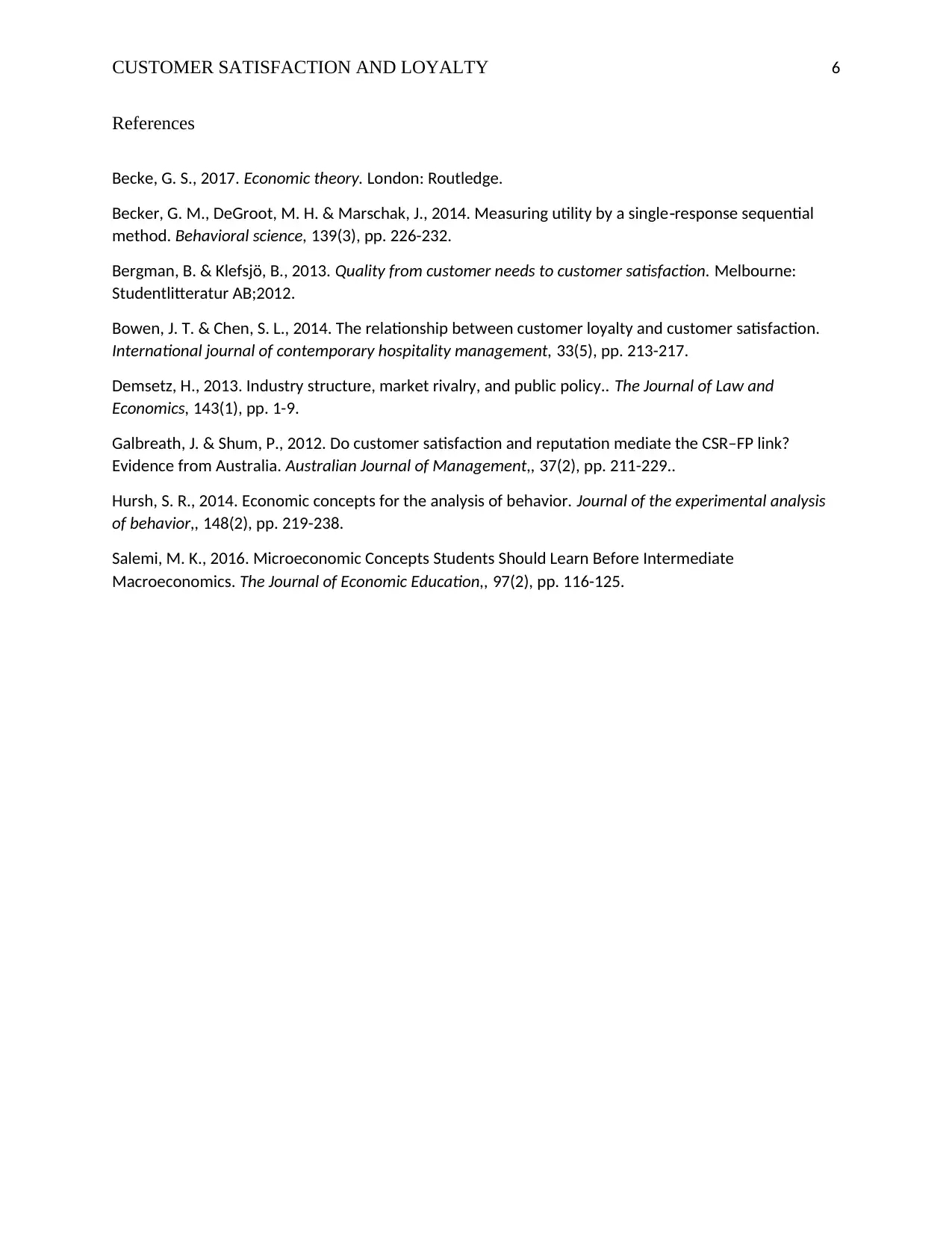
CUSTOMER SATISFACTION AND LOYALTY 6
References
Becke, G. S., 2017. Economic theory. London: Routledge.
Becker, G. M., DeGroot, M. H. & Marschak, J., 2014. Measuring utility by a single response sequential‐
method. Behavioral science, 139(3), pp. 226-232.
Bergman, B. & Klefsjö, B., 2013. Quality from customer needs to customer satisfaction. Melbourne:
Studentlitteratur AB;2012.
Bowen, J. T. & Chen, S. L., 2014. The relationship between customer loyalty and customer satisfaction.
International journal of contemporary hospitality management, 33(5), pp. 213-217.
Demsetz, H., 2013. Industry structure, market rivalry, and public policy.. The Journal of Law and
Economics, 143(1), pp. 1-9.
Galbreath, J. & Shum, P., 2012. Do customer satisfaction and reputation mediate the CSR–FP link?
Evidence from Australia. Australian Journal of Management,, 37(2), pp. 211-229..
Hursh, S. R., 2014. Economic concepts for the analysis of behavior. Journal of the experimental analysis
of behavior,, 148(2), pp. 219-238.
Salemi, M. K., 2016. Microeconomic Concepts Students Should Learn Before Intermediate
Macroeconomics. The Journal of Economic Education,, 97(2), pp. 116-125.
References
Becke, G. S., 2017. Economic theory. London: Routledge.
Becker, G. M., DeGroot, M. H. & Marschak, J., 2014. Measuring utility by a single response sequential‐
method. Behavioral science, 139(3), pp. 226-232.
Bergman, B. & Klefsjö, B., 2013. Quality from customer needs to customer satisfaction. Melbourne:
Studentlitteratur AB;2012.
Bowen, J. T. & Chen, S. L., 2014. The relationship between customer loyalty and customer satisfaction.
International journal of contemporary hospitality management, 33(5), pp. 213-217.
Demsetz, H., 2013. Industry structure, market rivalry, and public policy.. The Journal of Law and
Economics, 143(1), pp. 1-9.
Galbreath, J. & Shum, P., 2012. Do customer satisfaction and reputation mediate the CSR–FP link?
Evidence from Australia. Australian Journal of Management,, 37(2), pp. 211-229..
Hursh, S. R., 2014. Economic concepts for the analysis of behavior. Journal of the experimental analysis
of behavior,, 148(2), pp. 219-238.
Salemi, M. K., 2016. Microeconomic Concepts Students Should Learn Before Intermediate
Macroeconomics. The Journal of Economic Education,, 97(2), pp. 116-125.
⊘ This is a preview!⊘
Do you want full access?
Subscribe today to unlock all pages.

Trusted by 1+ million students worldwide
1 out of 6
Related Documents
Your All-in-One AI-Powered Toolkit for Academic Success.
+13062052269
info@desklib.com
Available 24*7 on WhatsApp / Email
![[object Object]](/_next/static/media/star-bottom.7253800d.svg)
Unlock your academic potential
Copyright © 2020–2025 A2Z Services. All Rights Reserved. Developed and managed by ZUCOL.





